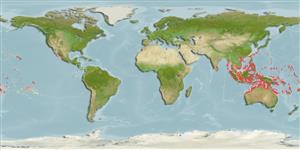Common names from other countries
>
Eupercaria/misc (Various families in series Eupercaria) >
Labridae (Wrasses) > Corinae
Etymology: Macropharyngodon: Greek, makros = great + Greek, pharyngx = pharynx + Greek,odous = teeth (Ref. 45335).
More on author: Herre.
Environment: milieu / climate zone / depth range / distribution range
Ecologia
marinhas associadas(os) a recifes; não migratória; intervalo de profundidade 8 - 32 m (Ref. 1602), usually 8 - 32 m (Ref. 27115). Tropical; 24°C - 28°C (Ref. 27115); 30°N - 24°S
Eastern Indian Ocean and Western Pacific: Andaman Sea (Ref. 9710) and Christmas Island (Ref. 30874) to the Philippines and Samoa, north to Ryukyu Islands, south to northern Australia.
Tamanho / Peso / Idade
Maturity: Lm ? range ? - ? cm
Max length : 12.0 cm TL macho/indeterminado; (Ref. 9710)
Espinhos dorsais (total) : 9; Raios dorsais (total) : 11; Espinhos anais: 3; Raios anais : 11; Vértebras: 25. Color in life of black with iridescent blue-green spots on body and light yellow antero-dorsally on head body; head banded. Anterior lateral line pored scales 2-3. Males display with metallic green shiny color that is turned on shortly for the occasion (Ref. 48636).
Inhabits lagoon and seaward reefs, in areas of mixed sand and coral (Ref. 9710). Post pelagic juveniles carried by currents beyond their normal breeding range. They are often in pairs or small loose groups, swimming close to the bottom. When approached, they move up and down in an unusual way that may worry a possible predator. Adults move about in small groups. (Ref. 48636).
Ciclo de vida ou comportamento de acasalamento
Maturities | Reprodução | Spawnings | Egg(s) | Fecundities | Larvas
Oviparous, distinct pairing during breeding (Ref. 205).
Randall, J.E., 1978. A revision of the Indo-Pacific labrid fish genus Macropharyngodon, with descriptions of five new species. Bull. Mar. Sci. 28(4):742-770. (Ref. 2694)
Status na Lista Vermelha da UICN (Ref. 130435)
CITES (Ref. 128078)
Not Evaluated
Ameaça para os humanos
Harmless
Uso pelos humanos
Pescarias: espécies comerciais; Aquário: Espécies comerciais
Ferramentas
Relatórios especiais
Baixar XML
Fontes da internet
Estimates based on models
Preferred temperature (Ref.
115969): 25.2 - 29, mean 28.1 (based on 866 cells).
Índice de diversidade filogenética (Ref.
82804): PD
50 = 0.5002 [Uniqueness, from 0.5 = low to 2.0 = high].
Bayesian length-weight: a=0.00977 (0.00470 - 0.02030), b=3.07 (2.89 - 3.25), in cm Total Length, based on LWR estimates for this (Sub)family-body shape (Ref.
93245).
Nível Trófico (Ref.
69278): 3.5 ±0.4 se; based on size and trophs of closest relatives
Resiliência (Ref.
120179): Elevada, tempo mínimo de duplicação da população menor que 15 meses (Preliminary K or Fecundity.).
Fishing Vulnerability (Ref.
59153): Low vulnerability (10 of 100).
